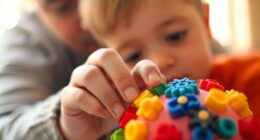As parents, we understand the importance of ensuring our newborns are comfortable and safe while they sleep. Although it may be tempting to try out different sleeping positions, it is crucial to follow safe sleeping guidelines, such as placing babies on their backs.
However, one vital aspect that often goes overlooked is…
Key Takeaways
- Back sleeping is essential for newborn safety and decreases the risk of SIDS.
- Room sharing without bed sharing promotes safer sleep environments.
- Creating a secure sleep space with firm surfaces and minimal bedding enhances safety.
- Consistent bedtime routines aid in regulating newborn sleep patterns and promote bonding.
Recommended Newborn Sleep Positions
When it comes to the recommended newborn sleep positions, placing your baby on their back is essential for promoting safe and sound sleep.
Back sleeping is vital as it greatly reduces the risk of Sudden Infant Death Syndrome (SIDS), a serious concern for infant safety during sleep.
By having your baby sleep on their back, you're creating a safer environment that aids in easier breathing and minimizes the chances of choking hazards while they rest peacefully.
Studies have shown that back-sleeping also leads to fewer instances of fevers, stuffy noses, and ear infections in babies.
It's important to prioritize this position to safeguard your little one's well-being and provide them with the safest sleeping environment possible.
Safe Co-Sleeping Guidelines
Sharing a bed with your baby, known as co-sleeping, poses potential risks that can be mitigated by following safe co-sleeping guidelines recommended by experts. When it comes to ensuring a safe sleep environment for your little one, consider the following:
- Room Sharing: Opt for room sharing instead of bed sharing to reduce the risk of SIDS.
- Separate Sleep Surfaces: Maintain separate sleep surfaces for you and your baby to prevent accidental suffocation and entrapment.
- Monitoring: Keep your baby within arm's reach for easy monitoring throughout the night.
- Comforting: Being close allows you to quickly comfort your baby if needed, promoting a sense of security and well-being.
Creating a Secure Sleep Environment

To provide a secure sleep environment for your newborn, prioritize using a firm, flat sleep surface like a crib to reduce the risk of SIDS. Keeping your baby's sleep area free of soft bedding and toys is important to prevent suffocation hazards.
Room sharing with your little one for at least the first 6 months allows you to monitor their sleep easily and attentively. Dressing your baby in light layers or opting for wearable blankets guarantees both comfort and safety during sleep.
It's essential to steer clear of smoking near your baby or exposing them to secondhand smoke to safeguard their health and well-being. By following these safe sleep practices, you reduce the risk of sudden infant deaths.
Importance of Sleep Routine

Establishing a consistent sleep routine is fundamental for regulating your newborn's internal clock and promoting better sleep patterns. Babies thrive on predictability, so a bedtime routine can signal that it's time to sleep. A bedtime routine can include activities like a warm bath, gentle massage, or soothing lullabies. Consistent sleep routines can reduce bedtime struggles and help babies fall asleep more easily. Following a bedtime routine can lead to better quality sleep for both the baby and the parents.
- Predictability: Babies find comfort in knowing what to expect before bedtime.
- Routine Consistency: Regularity in bedtime activities can create a sense of security for your baby.
- Quality Sleep: Establishing a bedtime routine can improve the duration and quality of your baby's sleep.
- Bonding Time: Bedtime routines provide an opportunity for intimate moments with your little one.
Safe Sleep Tips for Newborns

Placing your newborn on their back is essential for ensuring safe and sound sleep. Back-sleeping reduces the risk of Sudden Unexplained Infant Death (SUID) and helps babies breathe easier while lowering choking hazards. Research indicates that infants who sleep on their backs experience fewer fevers, stuffy noses, and ear infections.
To enhance safe sleep practices, consider using the SNOO Smart Sleeper, which prevents babies from rolling into unsafe positions during sleep. The FDA has granted the SNOO De Novo Authorization, recognizing its effectiveness in keeping infants secure on their backs.
Frequently Asked Questions
What Is the Safest Position for a Newborn to Sleep?
The safest position for a newborn to sleep is on their back. It reduces the risk of Sudden Infant Death Syndrome (SIDS), helps them breathe easier, and lowers choking hazards. Back-sleeping infants have fewer fevers, stuffy noses, and ear infections.
How Can My Newborn Safely Sleep in My Bed?
We guarantee our newborn sleeps safely in our bed by keeping soft bedding away, using a separate sleep surface like a bassinet, and supervising closely. We prioritize a firm, flat surface to reduce SIDS risks.
What Is the Safe Sleep Advice for Newborns?
We prioritize newborn safety by advocating back-sleeping. It reduces Sudden Unexplained Infant Death risk, promotes better breathing, and lowers choking dangers. The FDA-authorized SNOO Smart Sleeper guarantees babies stay in secure positions during sleep, enhancing peace of mind.
What Is the Best Way to Lay a Newborn Down to Sleep?
We always lay our newborns down to sleep on their backs; it's the safest way to reduce the risk of SIDS. Research shows that back-sleeping infants have lower rates of fevers, stuffy noses, and ear infections.
How Can Safe Sleep Positioning Tips Help with Newborn Sleep Training?
When it comes to comprehensive newborn sleep training, safe sleep positioning tips play a crucial role in ensuring successful and restful nights for both the baby and the parents. By following recommended sleep positions, parents can greatly improve their child’s sleep quality and overall well-being.
Conclusion
As parents, we must prioritize our newborns' safety during sleep time. Remember, placing babies on their backs reduces the risk of Sudden Infant Death Syndrome (SIDS).
Did you know that following the safe sleep guidelines can decrease the chances of SIDS by up to 50%?
By creating a secure sleep environment, maintaining safe sleep practices, and establishing a consistent sleep routine, we can help our little ones rest peacefully and safely.
Always prioritize safe sleep for your precious newborn.









